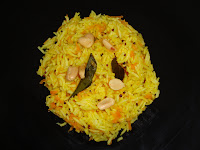
Tomato Pachadi/Raita
Tomato is an everyday vegetable in our household. I would normally feel very uncomfortable if I had anywhere less than 4 tomatoes in stock. I think it is such a versatile vegetable and possibilities are endless with tomatoes. In a way, tomato does amaze me. I was always used to having cooked tomato. My husband was insisting on me eating more fresh vegetables in the form of salads and so one fine day I tried adding tomato to the channa sundal when snacking at work. Few minutes later my mouth felt funny and kind of itchy and burning. I thought it may be the tomato but just ignored it. Couple of years later when I was tested for allergies for a different reason they found that I was allergic to uncooked tomatoes. I found it quite strange coz I seem to be bothered only when I eat uncooked cut tomato but tomato juice does no harm.
My mother-in-law does a far simpler version of tomato raita wherein she mixes cut tomatoes with curd and seasons. However, due to my allergies and preference to my mom’s raita recipe, I always do it my mom’s way.
3 big tomatoes cut into bite sized cubes
2 green chillies
1 cup yogurt/curd
Mustard seeds
Few curry leaves
Turmeric powder
Chilly powder
Cooking oil
Asafoetida
In a kadai heat oil and put the mustard seeds. After the seeds stop spluttering, add some turmeric powder and curry leaves and ensure they do not get burnt. Add the green chillies and tomatoes. As I prefer to have the tomatoes a bit chunky in the raita but at the same time I want it to be well cooked with in its own juice, I add a little bit of salt at this stage. Once the tomatoes are cooked, add some chilly powder. Cook for a couple of more minutes and season. Add the yogurt/curd and if desired garnish with coriander leaves.
I make this recipe atleast once a week to go with lime rice. It tastes great when mixed with plain rice and even curd rice.
Tomato is supposed to be rich in Vitamin A and C and is one of the five-a-day veggie. I find this a yummy way to have the healthy and beautiful tomato !! And as I understand, tomatoes are considered as fruit and not veggie !!










